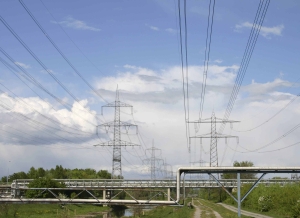As a result of the energy turnaround, a large fluctuating amount of renewable energy will be fed decentrally into the power grid. Ideally, it should be used and stored locally to make the extension of the long-distance transmission grid unnecessary. This requires new concepts for power use, conversion, and storage on a local level in cities and municipalities. Karlsruhe Institute of Technology (KIT) now cooperates with partners in the RegEnKibo project to develop smart grid technology and infrastructure for future regional energy supply. The project in the model city of Kirchheimbolanden is now funded by the Federal Ministry for Economic Affairs and Energy (BMWi) with EUR 2.2 million for a period of three years.
“The key to regionalizing power supply and to economically efficiently compensating fluctuations of wind-based and solar power is local storage of surplus power,” Mathias Kluwe of the KIT Institute for Control Systems explains. He coordinates the RegEnKibo project at KIT. “This can only be done by an optimum integration of the different partial energy systems.”
Within the framework of the project, intelligent interlinkage and control of components, such as wind turbines, solar cells, batteries, power-to-gas systems (PtG), gas storage systems, and co-generation units, in a seamless energy grid are conceived. This means that the power grid and the gas grid of Kirchheimbolanden are modeled and interlinked in a joint control network. It is the paramount objective to regionalize energy supply and to minimize compensation via the long-distance transmission grid. As a result, extended use of renewable energy sources would no longer require extension of power lines.
The energy system of the city is modeled on the computer and complemented by virtual components. Large batteries can store power for some hours or a few days. Power-to-gas systems convert electrical into chemical energy that can then be stored in the gas grid for some months in the form of methane. But how large do such systems have to be? Which amounts of power are needed for them to be economically efficient? How much energy still has to be taken from the long-distance transmission grid? Continuous evaluation of real-time data from about 60 sensors in the power grid is to provide the answers and to help optimize the model that might serve as a blueprint for an economically efficient and autonomous regional energy system.
The city of Kirchheimbolanden is a very good model location, as it possesses a variety of energy infrastructure facilities. Apart from well-developed power and gas grids, a number of solar facilities, co-generation units, a wind park, and a gas storage system are available. Power consumption is distributed representatively among households, business, and industry.
The project “Regionalization of Energy Supply on the Distribution Grid Level at the Model Location of Kirchheimbolanden” (RegEnKibo) will be funded by the Federal Ministry for Economic Affairs and Energy (BMWi) with EUR 2.2 million until summer 2018. The project is headed by the utility company e-rp GmbH, a company of the Thüga group. Apart from KIT, the partners are the University of Applied Sciences of Bingen and the Viessmann group. In a potential follow-up project, it is planned to implement the concepts developed under RegEnKibo. At Karlsruhe Institute of Technology (KIT) the DVGW test laboratory at the Engler-Bunte Institute, the Engler-Bunte Institute (EBI) itself, the Institute of Electric Energy Systems and High-Voltage Engineering (IEH), and the Institute for Control Systems (IRS) are involved. The KIT institutes participating in the RegEnKibo project also study these aspects under the programs of the Helmholtz Association.
More about the KIT Energy Center: http://www.energie.kit.edu
KIT possesses extensive scientific competences for research into, development, and integrated planning of the city of the future in all major aspects. Scientists of five KIT Centers – Climate and Environment; Energy; Mobility Systems; Humans and Technology; Informations, Systems, Technologies – work on studies and the sustainable design of urban spaces from their disciplines’ perspective and in an inter- and transdisciplinary manner.
Being “The Research University in the Helmholtz Association”, KIT creates and imparts knowledge for the society and the environment. It is the objective to make significant contributions to the global challenges in the fields of energy, mobility, and information. For this, about 10,000 employees cooperate in a broad range of disciplines in natural sciences, engineering sciences, economics, and the humanities and social sciences. KIT prepares its 22,800 students for responsible tasks in society, industry, and science by offering research-based study programs. Innovation efforts at KIT build a bridge between important scientific findings and their application for the benefit of society, economic prosperity, and the preservation of our natural basis of life. KIT is one of the German universities of excellence.

